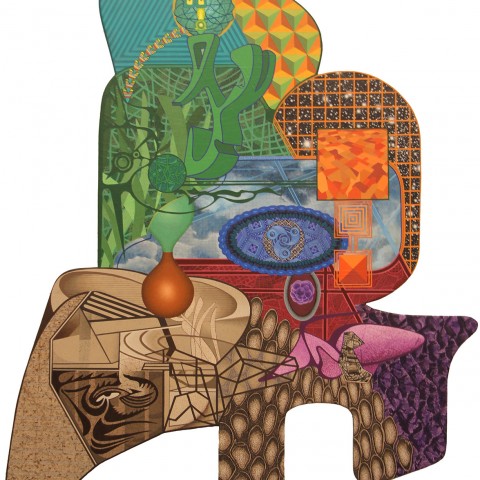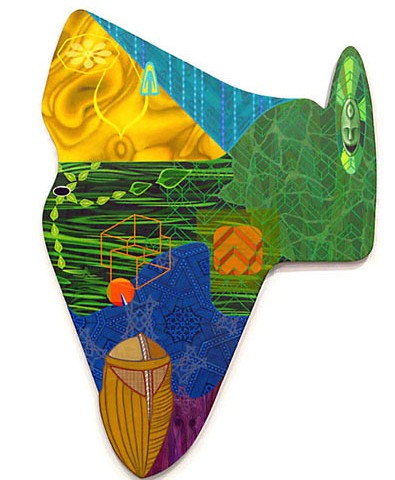David Wetzl @ JayJay
A widely shared expectation for artists is that they reflect the historical moment they inhabit. But for painter David Wetzl that’s never been enough. Wetzl accepts the notion of a prevailingzeitgeist, but he also believes representation of such moments must acknowledge something else: that vestiges of every stage of human history exist in the present, shaping reality as we know it.
To concretize that idea, Wetzl began reading Ken Wilber (A brief History of Everything) about 15 years ago. A pop philosopher who surveyed religion, science and psychology, Wilbur developed a color-coded “integrative map” of consciousness that describes human evolution. The paintings and drawings that come out of this worldview are necessarily complex.
Wetzl’s most ambitious expressions of it appear on wood panels, built up in sanded, varnished layers for a transparent, labyrinthine effect, reminiscent of Brazil, the Terry Gilliam film that portrayed the world as a subterranean maze of endless ductwork. I once described these works as “chaotic cocktails of representation and abstraction rendered in a slew of art historical styles (Cubism, Surrealism, Abstract Expressionism, Pop, Minimalism, Neo-Geo and P&D) that show reason, faith, genetic memory, biological imperatives and colliding in a sea of historic, pop cultural and technological effluvia.”
That description still holds.
This show, which spans more than 20 years, beginning in 1990, provides excellent examples, many of which call to mind the shaped canvases of Elizabeth Murray and the windowed views seen in the paintings of Lari Pittman.
You could spend a lot of energy trying to tease out possible allegories from all of the imagery. The most fruitful approach, I’ve found, is to focus on the infrastructure, the physical framework on which all of it hangs. It’s computer technology; specifically, the microprocessor-based circuitry that is the backbone of just about everything that communicates, stores or manipulates information. Years ago, before the Internet, Wetzl predicted that the interconnectivity afforded by these innovations would enable mankind’s next evolutionary step. (Recent revelations from Edward Snowden don’t appear to haven shaken his faith.) Circuit-like formations underpin much of the work, beginning with a suite of five charcoal-and-graphite drawings from the mid-1990s that line the gallery’s back wall, foreshadowing everything that would follow. The patterns, while clearly inspired by computer hardware, also bear a strong resemblance to cuneiform writing. In one drawing, the patterns appear inside a skull, suggesting that the distance between antiquity and modernity may not be all that great, and that the source code of the emerging virtual world is, itself, genetically embedded.
This back-to-the-future idea serves as a through line. Paintings and drawings carry inscrutable titles that refer to an alter ego (S.C.I.P.), a fictional “wisdom-based” corporation (TAICOOco.) and to other entities whose names (e.g. Synaptic Witness) feel drawn from a cyberpunk novel. If all of this feels a bit wacky, so be it. What saves it from actually being so is the way the artist integrates representational imagery with swatches of art-historical styles into a seamless, immersive whole out of which viewers can extract (or impose) whatever meanings they choose.
Wetzl, for his part, spins out detailed interpretations with the alacrity of a comedian, suggesting, with a nod and a wink, a laudable ability to laugh at himself. That stance is reflected in the show’s tongue-in-cheek title, Genius-ism — a clever pun on all the isms the artist packs into his paintings. About the only things missing are the brightly colored vinyl backdrops on which he once mounted large panel pieces; they dissolved the paintings’ edges, expanding our view and making it appear as the works had floated in on brightly colored clouds.
That DeLillo-esque device seemed to sum up Wetzl’s ethos well. As he put it to me some years back, “I’m a positive cynic.”
–DAVID M. ROTH




